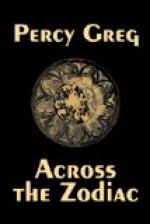And now a surprise, the first I had encountered, awaited me. I registered the gravity as shown by the barycrite; and, extinguishing the electric lamp, measured repeatedly the semi-diameter of the Earth and of the halo around her upon the discometer, the inner edge of the latter affording the measurement of the black disc, which of itself, of course, cast no reflection. I saw at once that there was a signal difference in the two indications, and proceeded carefully to revise the earth-measurements. On the average of thirteen measures the halo was about 87”, or nearly 1-1/2’ in breadth, the disc, allowing for the twilight round its edge or limb, about 2 deg. 50’. If the refracting atmosphere were some 65 miles in depth, these proportions were correct. Relighting the lamp, I worked out severally on paper the results indicated by the two instruments. The discometer gave a distance, roughly speaking, of 40 terrestrial radii, or 160,000 miles. The barycrite should have shown a gravity, due to the Earth’s attraction, not 40 but 1600 times less than that prevailing on the Earth’s surface; or, to put it in a less accurate form, a weight of 100 lbs. should have weighed an ounce. It did weigh two ounces, the gravity being not one 1600th but one 800th of terrestrial gravity, or just double what, I expected. I puzzled myself over this matter longer, probably, than the intelligent reader will do: the explanation being obvious, like that of many puzzles that bewilder our minds intensely, only to humiliate us proportionately when the solution is found—a solution as simple as that of Columbus’s egg-riddle. At length, finding that the lunar angle—the apparent position of the Moon—confirmed the reading of the discometer, giving the same apogaic distance or elevation, I supposed that the barycrite must be out of order or subject to some unsuspected law of which future observations might afford evidence and explanation, and turned to other subjects of interest.




